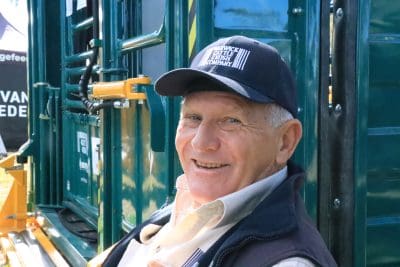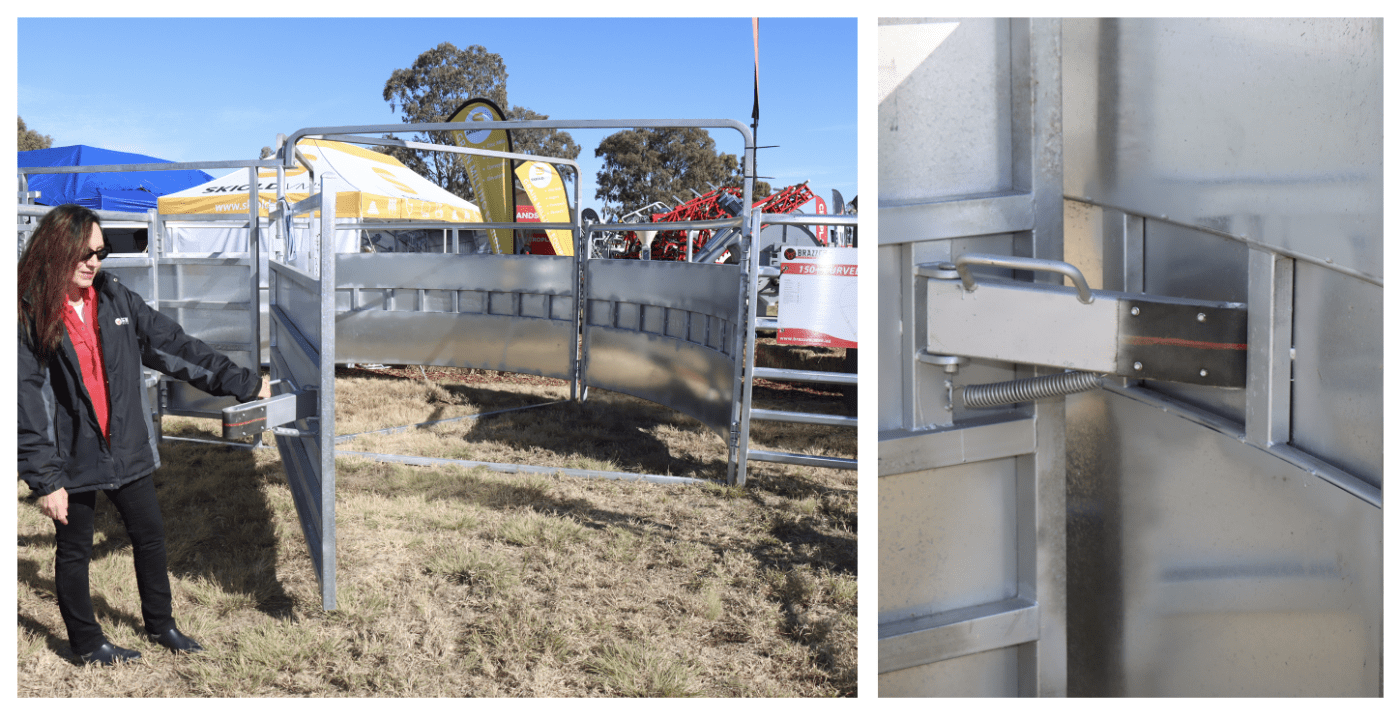What have been the key trends in cattle crush design and features over the past decade?
Several experts shared their opinions with Beef Central at FarmFest on Tuesday, with labour efficiency, safety, animal welfare, data collection and time-saving improvements all ranking high on the list.
 “Hydraulics and air” was the immediate response from Gary Stark, a veteran cattle crush manufacturer from Warwick Cattle Crush.
“Hydraulics and air” was the immediate response from Gary Stark, a veteran cattle crush manufacturer from Warwick Cattle Crush.
“It has taken a lot of the hard work out,” he said.
“In the last three years I have hardly sold a manual crush.”
Mr Stark said he used to sell 40 manual crushes a month, but that is now back to about 10, with hydraulic-powered crushes dominating demand instead.
“It is all about labour, safety and time. Instead of four or five people, two people can do the same amount of cattle in half the time.”
He also provided a demonstration of the light touch required to handle cattle and calves with hydraulically powered units, in this case a Warwick Cattle Crush calf cradle – see video:
Safety has been another major area of evolution.
Barb Wilkinson from Brazzen Rural Products said with many customers having their children working them, there has been an increase in demand for personnel races to separate people from cattle, and curved force yards with ratchet locks to prevent gates being slammed back on handlers.

Barb Wilkinson, Brazzen Rural Products, Kilcoy: “Safety is the big one, If I had my way, everyone would have a force yard” (left, and close up of ratchet lock right)”.
Another variation of safety-enhancing and stress-reducing innovations has been the emergence of new generation durable rubber flooring which is capable of handling heavy traffic, which has provided improved cleanliness, increased comfort for cattle and improved safety for both cattle and staff.
John Cullen from Dalby Rural Supplies said rubber flooring had been a “game-changer” in livestock handling in recent years.
“The cattle feel more stable and calm, the rubber flooring has made a huge difference,” he said.
Several manufacturers Beef Central spoke with also offer mobile or portable cattle crushes, in response to demand from producers seeking the flexibility to handle cattle in multiple locations rather than at one fixed site.
Automation and data collection go hand-in-hand
Automation and data collection working in synergy with crushes has been another key trend.
Several manufacturers at FarmFest offer machines that are connected directly to livestock management software and sensors to operate gates and head bales.
Te Pari’s Taurus crush was fully automated, meaning an operator could work the crush without laying a hand on a button or a lever – instead pre-set directions were put into livestock management software.
The company’s Duane Raddel told Beef Central that the crush had taken off in feedlots and on large backgrounding operations, where they were constantly trying to collect data and were larger companies that had managers and staff to look after.
Alongside safety and data collection, reducing reliance on labour was another benefit crush manufacturers were keen to push.
Cipex’s 2000 auto used buttons to control all gates in front of the animal going through the crush and sensors to shut gates behind them.
Tamworth-based product specialist Lachie Knight said reducing reliance on labour was the main benefit.
“You would look at a setup like this and think it is for a big operation, but it is really designed for an operation wanting to decrease its reliance on labour,” he said.
“You really only have room for two people in there, most likely the producer and the vet, anymore and it gets crowded.”
Companies seemed to have turnaround times under control
The supply of cattle crushes and other handling equipment has been an issue in the past decade, particularly over the COVID 19 period where access to raw materials and other restrictions were causing issues.
Most yard manufacturers who Beef Central asked about turnaround times said it would take one to two months get a crush into the yards if ordered from FarmFest.
Most said they had their own manufacturing and steel supply was not an issue.

